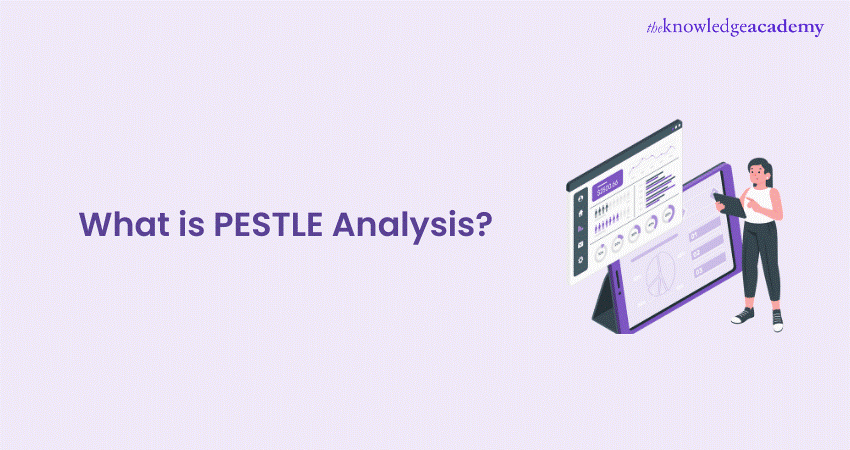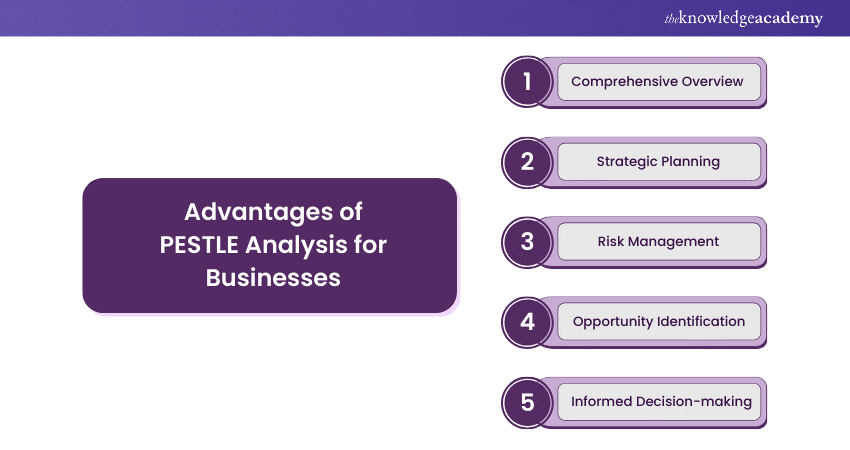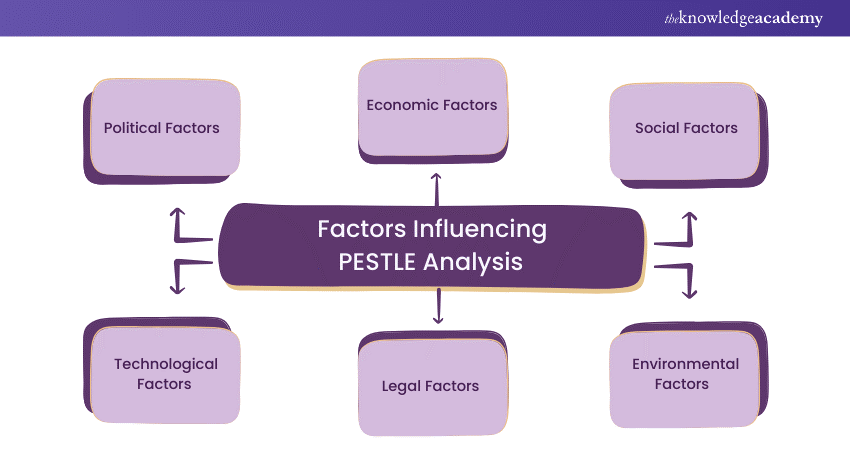We may not have the course you’re looking for. If you enquire or give us a call on 01344203999 and speak to our training experts, we may still be able to help with your training requirements.
Training Outcomes Within Your Budget!
We ensure quality, budget-alignment, and timely delivery by our expert instructors.

In the ever-evolving landscape of business, staying ahead of the curve is crucial. Enter the PESTLE Analysis—a strategic compass for navigating the external forces that shape business fortunes.
Picture it as a multifaceted gem, each facet representing a critical factor: Political, Economic, Social, Technological, Legal and Environmental. This blog explores What is PESTLE Analysis and how it can illuminate your path toward effective business strategies!
Table of Contents
1) Understanding What is PESTLE Analysis?
2) What is PESTLE Analysis Used for?
3) PESTLE Analysis Business Advantages
4) PESTLE Analysis Business Disadvantages
5) PESTLE Analysis Business Factors
6) PESTLE Analysis Examples
7) PESTLE Analysis Variations
8) What is the Difference Between PESTLE and SWOT Analysis
9) Conclusion
What is PESTLE Analysis?
PESTLE Analysis is a strategic framework for evaluating external factors affecting an organisation. It stands for Political, Economic, Social, Technological, Legal, and Environmental factors. By examining these elements, businesses can gain crucial insights into their external environment.
a) Political Factors: Government policies, regulations, political stability.
b) Economic Factors: Economic growth, inflation, interest rates, exchange rates.
c) Social Factors: Societal trends, demographics, consumer behaviours.
d) Technological Factors: Technological advancements, innovation, automation.
e) Legal Factors: Laws and regulations governing business practices.
f) Environmental Factors: Ecological and environmental considerations.
Understanding these factors helps businesses anticipate challenges and opportunities, supporting informed decision-making and strategic planning.
What is PESTLE Analysis Used for?
PESTLE Analysis is a versatile tool applicable across various aspects of a project. Here are key areas where it proves invaluable:
1) Business Strategy
Understanding the macro-environment is crucial for crafting a business strategy. PESTLE Analysis helps identify potential opportunities and threats, enabling informed strategic decisions. For instance, a company planning market expansion can assess political stability, economic conditions, and social trends in the target market.
2) Workforce Strategy
PESTLE Analysis informs workforce strategies by highlighting social and economic trends affecting labour markets. Changes in labour laws (Legal) or shifts in workforce demographics (Social) can influence hiring practices, employee benefits, and training programs.
3) Marketing Strategy
Marketing strategies must adapt to changing social and technological trends. PESTLE Analysis helps businesses understand consumer behaviour, technological advancements, and regulatory changes, ensuring relevant and compliant marketing campaigns.
4) Product Strategy
Product development benefits from PESTLE Analysis by identifying trends influencing consumer preferences and regulatory requirements. Environmental concerns (Environmental) may drive sustainable product development.
5) Organisational Change
During organisational change, considering external factors is essential. PESTLE Analysis provides insights into potential challenges and opportunities, such as economic downturns (Economic) or new regulations (Legal), impacting the success of change initiatives.
6) People Strategy
Human resources strategies can be optimised by understanding the broader socio-economic environment. PESTLE Analysis helps identify trends in education, skills availability, and workforce expectations, allowing businesses to align their people strategies with external realities.
Learn Business Analysis Skills with our BCS Certificate in Business Analysis Practice – Register now!
Advantages of PESTLE Analysis for Businesses
PESTLE Analysis provides numerous benefits for businesses, making it an essential tool for strategic planning:

a) Comprehensive Overview: PESTLE Analysis offers a thorough examination of the external factors influencing a business. By considering political, economic, social, technological, legal, and environmental aspects, it ensures no critical element is overlooked, providing a holistic perspective.
b) Strategic Planning: Understanding the macro-environmental factors allows businesses to develop robust and adaptive strategies. This proactive approach helps companies stay ahead of market trends and adapt to changes swiftly, ensuring long-term success.
c) Risk Management: Early identification of potential threats, such as regulatory changes or economic downturns, enables businesses to formulate effective mitigation plans. This foresight helps minimise risks and prepare for uncertainties.
d) Opportunity Identification: By highlighting emerging trends and opportunities, PESTLE Analysis can give businesses a competitive edge. Recognising new market potentials or technological advancements allows companies to capitalise on these opportunities and innovate.
e) Informed Decision-making: Data-driven insights derived from PESTLE Analysis lead to more informed and effective decision-making. Businesses can base their strategies on solid evidence, reducing the reliance on guesswork and enhancing overall efficiency.
Disadvantages of PESTLE Analysis for Businesses
Despite all its benefits, PESTLE Analysis also comes with certain limitations:
a) Complexity: Conducting a PESTLE Analysis can be complex and time-consuming. Significant research and expertise are required to assess the various factors accurately, which can be challenging for businesses with limited resources.
b) Dynamic Nature: The external environment is constantly changing, making it difficult to keep the analysis up to date. Businesses need to continuously monitor and revise their PESTLE Analysis to ensure its relevance, which can be resource intensive.
c) Subjectivity: The interpretation of factors in PESTLE Analysis can be subjective. Different analysts might have varying perspectives, leading to biased or inaccurate conclusions. It is essential to approach the analysis with objectivity and consider multiple viewpoints.
d) Scope Limitation: PESTLE Analysis focuses solely on external factors, potentially overlooking internal business dynamics. While it provides valuable insights into the external environment, businesses must also consider their internal strengths and weaknesses for a comprehensive strategy.
e) Resource Intensive: Conducting a thorough PESTLE Analysis demands certain resources, including time, expertise, and financial investment. Small businesses or those with limited budgets may find it challenging to allocate these resources effectively.
Factors Influencing PESTLE Analysis
To conduct a PESTLE Analysis effectively, it’s crucial to understand each of the factors in detail.

1) Political Factors
Political factors encompass government policies, regulations, and political stability affecting a business. This includes tax policies, trade restrictions, labour laws, and government stability. For instance, changes in trade policies can impact supply chain operations and market access.
2) Economic Factors
Economic factors cover the broader economic environment in which a business operates. This includes inflation rates, interest rates, economic growth, and exchange rates. These elements can affect purchasing power, cost structures, and profitability.
3) Social Factors
Social factors involve societal trends and behaviours influencing consumer preferences and workforce dynamics. This includes demographics, cultural attitudes, health consciousness, and lifestyle changes. Understanding these trends helps businesses tailor their products and services to meet customer needs.
4) Technological Factors
Technological factors relate to the impact of technological advancements and innovation on a business. This includes the adoption of new technologies, research and development activities, and automation. Keeping up with technological trends is vital for maintaining competitiveness and efficiency.
5) Legal Factors
Legal factors involve the regulatory framework within which a business operates. This includes laws related to employment, health and safety, consumer protection, and environmental regulations. Compliance with legal requirements is crucial to avoid penalties and legal disputes.
6) Environmental Factors
Environmental factors refer to the ecological and environmental aspects that can impact a business. This includes climate change, sustainability practices, and environmental regulations. Growing environmental awareness among consumers also drives the demand for sustainable products and practices.
PESTLE Analysis Examples
Let’s take a look into some real-world PESTLE Analysis examples to better understand how this framework applies to different contexts.
PESTLE Analysis Example of a Company
a) Nike: Nike, a global sportswear brand, would assess factors like political stability (e.g., trade policies affecting imports and exports), economic conditions (currency exchange rates, inflation), social trends (athletic lifestyle preferences), technological advancements (wearable fitness tech), legal requirements (intellectual property laws), and environmental concerns (sustainable materials) to inform its business strategies.
b) Apple: Apple’s PESTLE Analysis would consider political factors (taxation policies, privacy regulations), economic factors (global economic growth, consumer spending), social trends (tech adoption rates, lifestyle changes), technological advancements (product innovation), legal aspects (patents, antitrust laws), and environmental impact (e-waste management).
c) Tesla: Tesla’s PESTLE Analysis would explore political factors (government support for electric vehicles), economic conditions (EV market growth), social trends (environmental consciousness), technological developments (battery technology), legal requirements (emissions standards), and environmental concerns (carbon footprint reduction).
d) Coca-Cola: Coca-Cola's PESTLE analysis evaluates political influences (regulations on sugar taxes), economic factors (currency fluctuations), socio-cultural trends (health-conscious consumer preferences), technological advancements (digital marketing), legal considerations (food safety regulations), and environmental impacts (sustainability initiatives) to shape its strategic decisions and market positioning globally.
e) Starbucks: Starbucks, a leading coffee retailer, conducts a PESTLE analysis focusing on political stability, economic factors like consumer spending, social trends influencing coffee culture, technological advancements in digital ordering, legal regulations on food safety, and environmental sustainability in sourcing practices.
Learn about the key Data Protection Principles and Terminology with our BCS Foundation Certificate in Data Protection Training - Join now!
PESTLE Analysis Variations
PESTLE Analysis has several variations tailored to different analytical needs. Each variant provides a unique approach to examining specific aspects. Common variations include:
a) PEST Analysis: Focuses on Political, Economic, Social, and Technological factors.
b) PESTEL Analysis: Often used interchangeably with PESTLE, it includes Environmental and Legal factors, adding depth to the traditional PEST framework.
c) STEEP Analysis: Covers Social, Technological, Economic, Environmental, and Political factors.
d) SPELIT Analysis: Expands the traditional PEST framework by adding Information and Technology factors.
What is the Difference Between PESTLE and SWOT Analysis?
Here's a table highlighting the differences and purposes of PESTLE and SWOT analyses:
|
Aspect |
PESTLE Analysis |
SWOT Analysis |
|
Focus |
External macro-environmental factors |
Both internal and external factors |
|
Scope |
Political, Economic, Social, Technological, Legal, Environmental |
Strengths, Weaknesses, Opportunities, Threats |
|
Purpose |
Identify opportunities and threats from the external environment |
Provide a balanced view of internal and external factors |
|
Application |
Strategic planning, risk management |
Internal strategic planning, performance reviews |
|
Integration |
Focuses on external context |
Integrates internal and external perspectives |
|
Depth vs Breadth |
In-depth analysis of external factors |
Broad overview of internal and external factors |
|
Use Cases |
Market entry analysis, risk assessment, long-term planning |
Internal audits, short-to-medium-term planning |
|
Example of Questions Asked |
How do political changes affect our market? |
What are our internal strengths and weaknesses? |
|
Typical Outputs |
Detailed insights into external conditions |
Actionable strategies to leverage strengths and mitigate threats |
Explore how to identify, assess, and evaluate Information Risks with our BCS Practitioner Certificate in Information Risk Management Training – Sign up today!
Conclusion
We hope this blog clarifies What is PESTLE Analysis. From political to environmental factors, each category presents variables impacting businesses. Conducting a PESTLE Analysis helps identify market threats and opportunities, enabling informed decisions and strategies aligned with goals. Whether you are launching a product or navigating organisational changes, PESTLE Analysis offers a significant advantage.
Register with our Business Analysis Courses and learn critical data-driven skills!
Frequently Asked Questions

Threats in PEST Analysis may include deregulation. This exposes one to intense competition, a reduced market, and increases interest rates. It can cause problems if the company is burdened by debt.

Success is subjective. It depends on what degree of success is enough for a certain individual. Success for one influencer might not be satisfactory enough for another.

The Knowledge Academy takes global learning to new heights, offering over 30,000 online courses across 490+ locations in 220 countries. This expansive reach ensures accessibility and convenience for learners worldwide.
Alongside our diverse Online Course Catalogue, encompassing 17 major categories, we go the extra mile by providing a plethora of free educational Online Resources like News updates, Blogs, videos, webinars, and interview questions. Tailoring learning experiences further, professionals can maximise value with customisable Course Bundles of TKA.

The Knowledge Academy’s Knowledge Pass, a prepaid voucher, adds another layer of flexibility, allowing course bookings over a 12-month period. Join us on a journey where education knows no bounds.

The Knowledge Academy offers various Business Analysis Courses, including BCS Practitioner Certificate in Requirements Engineering, BCS Business Analysis Diploma Oral Preparation Workshop, and BCS Practitioner Certificate in Digital Product Management. These courses cater to different skill levels, providing comprehensive insights into Business Analysis Services.
Our Business Analysis Blogs cover a range of topics related to PESTLE Analysis, offering valuable resources, best practices, and industry insights. Whether you are a beginner or looking to advance your Business Analysis skills, The Knowledge Academy's diverse courses and informative blogs have got you covered.
Upcoming Business Analysis Resources Batches & Dates
Date
 BCS Certificate in Business Analysis Practice
BCS Certificate in Business Analysis Practice
Mon 16th Sep 2024
Mon 30th Sep 2024
Mon 28th Oct 2024
Sat 2nd Nov 2024
Mon 25th Nov 2024
Mon 9th Dec 2024
Mon 6th Jan 2025
Mon 20th Jan 2025
Mon 3rd Feb 2025
Mon 17th Feb 2025
Mon 3rd Mar 2025
Mon 17th Mar 2025
Mon 7th Apr 2025
Mon 12th May 2025
Mon 9th Jun 2025
Mon 7th Jul 2025
Mon 4th Aug 2025
Mon 1st Sep 2025
Mon 6th Oct 2025
Mon 20th Oct 2025
Mon 3rd Nov 2025
Mon 17th Nov 2025
Mon 1st Dec 2025
Mon 15th Dec 2025







 Top Rated Course
Top Rated Course



 If you wish to make any changes to your course, please
If you wish to make any changes to your course, please


